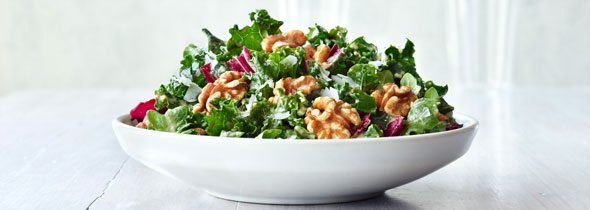
Cracking the Basics of Plant-based Eating
If you’re looking for a healthy way to eat every day that is simple, suits the whole family, and tastes great too, then look no further. Plant-based eating is a great option and doesn’t have to be “all or nothing.” You don’t have to go meat-free to be more plant-based.
According to ‘The Eatwell Guide’, published in March 2016, three quarters of our diet should now come from plant-based food.
What is it?
Fruits and vegetables, whole grains and a variety of protein-rich foods like beans and peas, nuts, seeds and soy (like edamame) are the mainstays of plant-based eating. Low-fat milk and dairy products, seafood, lean meat, poultry and eggs can also be included if desired, but are not the focus of plant-based menus. It is not exclusionary, but rather about being more mindful of plant sources of protein. The use of sugars, salt and saturated fats should all be minimal.
Why Plant-Based?
Compared to a typical diet, a plant-based philosophy is higher in unsaturated fats and fibre, both of which support better health. It can be more nutrient-dense and contain more vitamins, minerals and phytonutrients, which help to reduce your risk for chronic disease. Plant-based diets offer a great variety of flavours and textures. View the Plant-based shopping list here.
More Plants, Not Meatless
Plant-based eating doesn’t have to be vegetarian or vegan. There are a number of plant-based eating plans like the Mediterranean Diet and Dietary Approaches to Stop Hypertension (DASH) that include small amounts of poultry, lean red meat and seafood. If you prefer an entirely vegetarian regimen, however, there are plenty to choose from. Part of the beauty is that plant-based eating is customizable to your unique preferences. For some, the transition to a diet with more plant-based foods is best accomplished through gradual steps. In general, the recommended serving size for animal protein in a meal is three ounces. Try making that three-ounce threshold your first goal, then reduce the meat content from there as desired.
Plants & Protein
Plant sources of protein include nuts, beans and other legumes, peas, seeds, tofu, tempeh (a fermented soy product), and whole grains like brown rice, faro, sorghum, and quinoa. When combined with walnuts, plant-based dishes can be just as satisfying as comparable portions of meat-based dishes, due to plant-based meals being higher in fibre.
Good Fats
There is a lot of talk about good and bad fats, but it’s not quite as simple as that. Your body actually needs dietary fat for energy and to process certain vitamins and minerals. What you need to know is that it’s all about balance: between saturated and unsaturated fats.
What is Saturated Fat?
While there are some exceptions, most saturated fats are solid at room temperature such as butter, ghee, lard. A diet high in saturated fat may raise your low-density lipoprotein (LDL) cholesterol levels which could increase your risk of heart disease and type 2 diabetes.
What is Unsaturated Fat?
Most unsaturated fats tend to be liquid at room temperature and replacing saturated fat with unsaturated fat can improve your health. Unsaturated fat comes from plants and can be found in:
- vegetable oils
- olives
- nuts (such as walnuts) and seeds
- some fish
There are two main types of unsaturated fat which include monounsaturated fats (MUFA) and polyunsaturated fats (PUFA). Current UK dietary guidelines recommend that the majority of our fat intake should come from these two heart-friendly unsaturated types.
Walnuts are unique among nuts for they are primarily comprised of PUFAs, with 14 out of 19 grams of total fat per 30g serving. As a result, walnuts are the only tree nut that offers an excellent source of the plant-based omega-3 fatty alpha-linolenic acid (ALA). In other words, 83% of a walnut’s fat content is unsaturated. That means that when you eat walnuts in place of another food that’s high in saturated fat (e.g. chocolates), they can help to lower cholesterol levels too.
Omega-3 Fatty Acids
There are three kinds of omega-3 fatty acids: Alpha-Linolenic acid (ALA), which is found in plant-based foods, and eicosapentaenoic acid (EPA) and docosahexaenoic acid docosahexaenoic acid (DHA),which comes from marine sources.
As your body cannot make ALA, you must get it from the foods you eat. Our bodies need omega-3 fats, including ALA, for everyday functions – including helping to maintain normal cholesterol levels, which is important for heart health. Enjoying a 30g handful of walnuts each day is a great way to get your omega-3 fix, as they are a source of ALA.
How do I add more plant-based food to my diet?
Focus on adding. Instead of dining on just chicken and rice, add a cup of sautéed broccoli, roasted carrots or mix in cauliflower rice. Fruits like peaches and berries make for delicious plant-based additions to desserts and walnuts will give them that extra crunch. For snacks, try setting out a bowl of toasted or seasoned walnuts to nibble on throughout the day. Plant-based eating is not an all-or-nothing proposition. If it helps you get started, choose just one day each week to focus on plant-based meals.
Too Busy to Cook?
A slow cooker or pressure cooker is the most important ally a busy plant-based eater can have. One-pot meals can simmer to flavourful perfection while you’re working or sleeping. They also happen to be a great way to cook dried beans. When dining out, Mediterranean, Asian and Mexican cuisines typically offer more options for people wanting to include vegetables and beans.
Your Next Meal
Now that you know, it’s time to take action. Check out the plant-based recipe collection page for a variety of tasty ideas, and make your next meal the first in a shift toward healthier eating.

